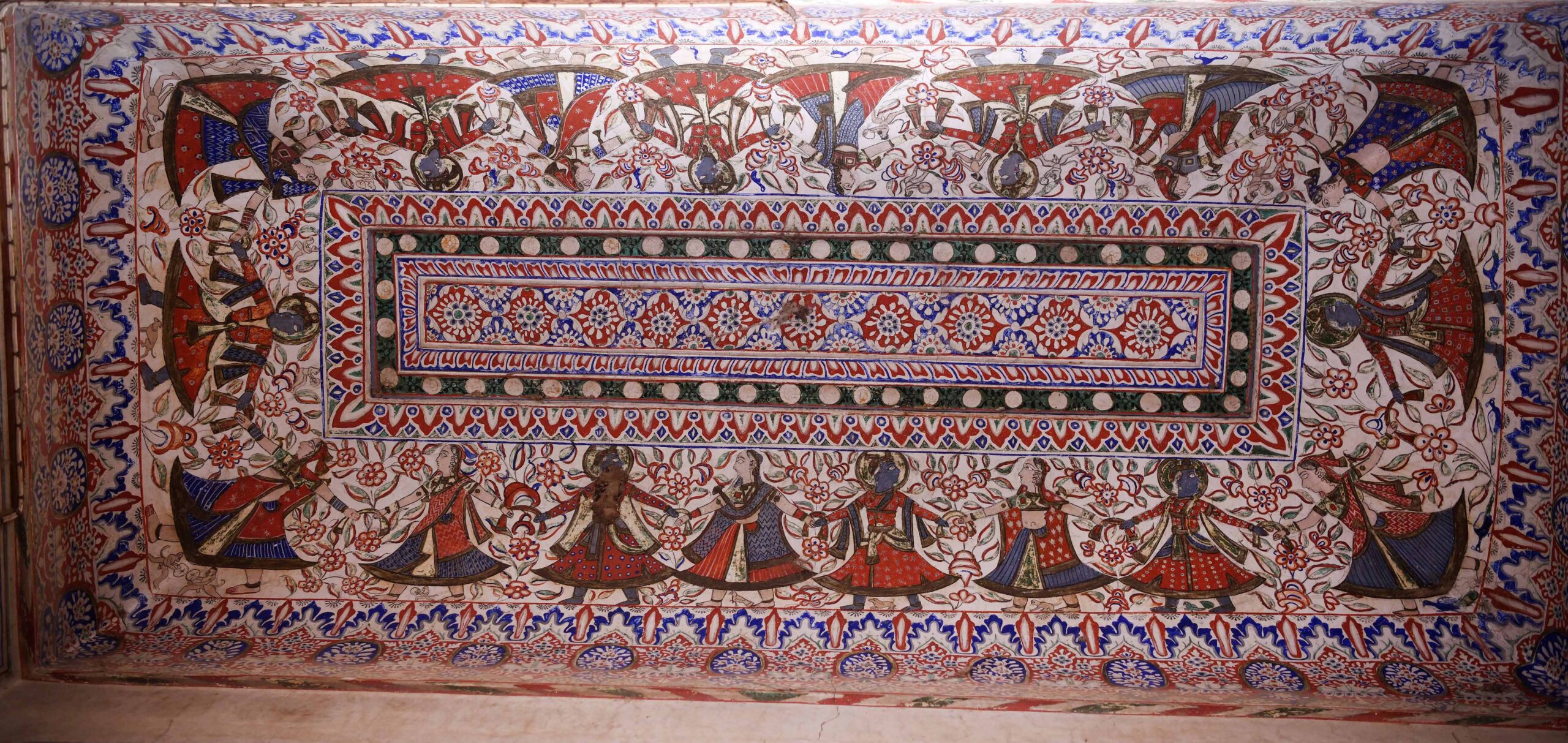Shekhawati art is one of Rajasthan’s signature traditions of painting and can be traced back to the 17th century, owing its name to Rao Shekha – a Rajput ruler. Strewn across the Jhunjhunu, Sikar and Churu districts, Shekhawati means the ‘garden of Shekha’ (wati means garden).

Shekhawati artwork is mostly dominated by figures of animals, birds and humans. Long panel work depicting scenes such as bridal processions or army columns are commonplace. Several houses feature cast iron grilles that were imported from England. These are characteristically designed with decorative motifs.

The frescos featuring richly decorated figurative paintings on temples, chhatris, houses and forts flourished under Rajput rulers and native merchants. Many of these havelis are concentrated in Fatehpur, a small city in Sikar, today home to a unique open sky heritage museum spread all around the city. A mere three-hour drive from Jaipur, it is ideal for a day trip.

Most of the buildings here are more than 150 years old, with beautiful wall art adorning the bylanes interspersed with temples and havelis. The main street of the town is narrow and crowded in the Chatria and Baori Gate Bus stand area, but beyond that point the thoroughfare is wide and empty, where one can still see carts pulled by donkeys, relics of a bygone era.

To save this heritage from certain ruin, restoration efforts are underway, the most prominent of which is ‘The Shekhawati Project’ led by Cécile Charpentier, a Franco-American expert in conservation and restoration of paintings. During her travels around India, Charpentier was astonished to see how a unique fresco technique that originated in Italy was adapted by Indian artisans using local materials. The first workshop of the Project was organised in 2017 in Le Prince Haveli in Fatehpur when participants worked on an ethical protocol to preserve this heritage home, combining the traditional knowhow of indigenous craftsmen with modern restoration technology. Along with training and restoration, the project also tried to address waste management and flooding so as to take a holistic approach to the conservation of the monuments.

“The paintings in the Shekhawati region consist of different layers of lime plaster applied over a sandstone or brickwork structure. The original pigments used, such as artificial ultramarine blue, chrome red, red ochre, emerald green, and carbon-based black are mostly of inorganic origin. They were applied either through the fresco (when the plaster is still fresh and wet) or a secco technique (where the plaster has already dried and carbonated), the latter consisting of the use of lime or natural gums as additional binders.” says Harpreet Tanday, a wall paintings and stone conservator working on the Project’.

“The pigments that we use for the project are specially designed watercolours made for conservation use and thus, without impurities. We use watercolours in conservation because they are compatible with the original pigments and are reversible over time. Our conservation approach aims to respect the original materials and pigments and work following the principles of material compatibility, reversibility and re-treatability,” adds Tanday.

An unusual panel of note is a pair of mirror work frescoes depicting Lord Krishna and Rukmini sitting in a back seat while Balaram drives a 1914 Rolls-Royce Silver Ghost Labourdette Skiff. Even the Mercedes Benz 24/100/140 PS Roadster is featured on a building at a major intersection. Another building close by displays a fading image of goddess Saraswati that is reminiscent of Raja Ravi Verma’s work.

“These frescoes on these buildings were initially painted in natural colours. Dyes and imported paints and pigments from Europe were employed over time. Even the subjects and style of paintings vary vastly across the different towns of the region. In some places red and blues are clearly dominant, whereas in many works mirrors and tiles have been used as decorative elements,” says prominent art restorer Ganesh Pratap Singh.

The panels cover broad themes such as decorative designs, daily life, religion, mythology, historical events or personalities, flora and fauna, or even changing lifestyles as a result of European influence. Dance scenes with Lord Krishna and gopis during Rasa-mandala (a sacred mythological event of Hindus which is still observed), stories of Laila-Majnu, Heer-Ranjha and Rajasthan’s popular romantic characters Dhola-Maru are common themes in the murals.
Information Box
-
Winter is the best time to visit.
- Connect with The Shekhawati Project (https://www.theshekhawatiproject.net) to join in on a workshop on restoration and Shekhawati Art.
-
A few havelis have been turned into hotels in the region, check online for the same.
- For a storyteller and guide connect with Prashant (8741983434)
-
Stop by at Tamaria Misthan Bhandar at Chota Bazar in Fatehpur for Dahi Vada, Boondi Ke Ladoo or Kachori.




